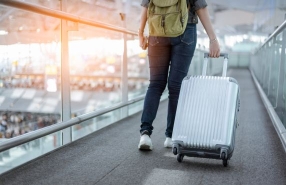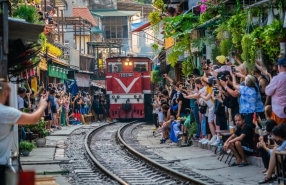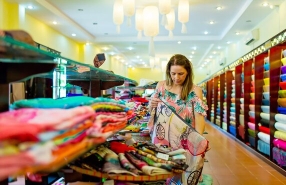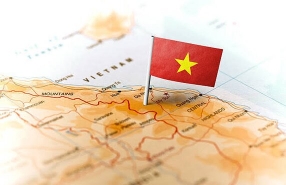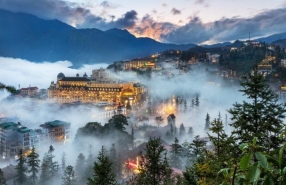Myanmar In March : Weather, Where To Go, What To See, Itinerary And FAQ
.jpg)
Planning to visit Myanmar in March and wondering what to do ? This comprehensive guide will help you plan your trip. With ideal weather, breathtaking landscapes, and lively festivals, March is the perfect time to explore this gem of Southeast Asia. From weather and practical tips to must-see attractions, we answer all your questions to ensure your stay is unforgettable. Plan your Myanmar adventure with Autour Asia, Travel and Tour in Myanmar.
Table of Contents
I. Weather in Myanmar in March
Weather in Myanmar in March is still perfect for traveling across most parts of the country, making it advisable to book early to secure the best accommodations.
Weather in Myanmar in March begins to heat up across many regions, with temperatures ranging from 30°C to 35°C. In the lowlands, highs average around 36°C, and even the eastern and northern highlands reach the low 30s°C. Being one of the dry months of the year, you won’t need to worry about rain across the country. There are no more chilly highland mornings, so you can expect excellent conditions across Myanmar.
The central plains, including major cities like Mandalay, Bagan, and Yangon, will be dry and gradually heat up, though it’s more manageable than in later months, with average temperatures around 36°C.
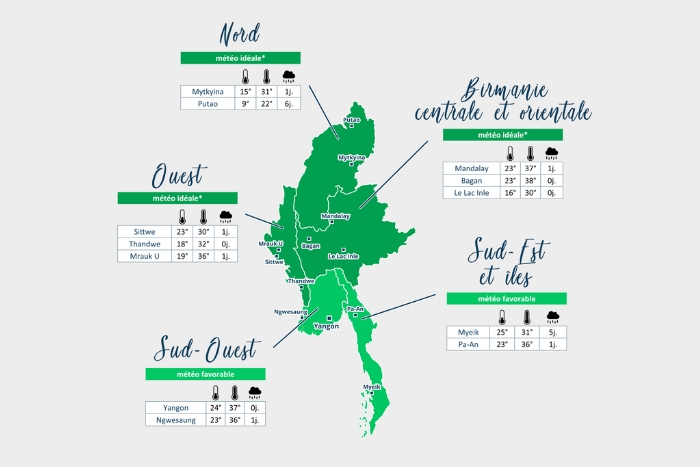
The chill has lifted from the foothills and the Shan region. In the south and along the west coast, the beaches are basking in sunshine. The beaches are fantastic at this time, with Myanmar in March offering ideal spots like Ngapali Beach, where temperatures hover around 31°C, accompanied by plenty of sunshine and cool breezes. On the waterways, water levels are among the year's lowest, so any cruise plans should be carefully considered. The lower sections of the Ayeyarwady River should still be navigable.
Outdoor activities in Myanmar in March can be a bit more uncomfortable than in January or February, especially at archaeological sites such as Bagan. However, overall, March is still suitable for outdoor activities if you prepare with water and hats to protect yourself from the sun. Cooler temperatures can be found around Inle Lake and Kalaw, with averages around 30°C, making these areas an excellent choice for a vacation in Myanmar in March.
Overall, the country is warm, sunny, and still dry, whether you're in the mountains or by the coast. Myanmar in March is undoubtedly one of the best moments to visit this captivating country.
II. What to do in Myanmar in March?
1. Discover Mrauk U
Mrauk U, located near the western border, is Myanmar’s second-largest temple complex after Bagan. The temples here are built from stone bricks, unlike the mud and clay brick temples found in Bagan. If you're planning to explore Myanmar in March, this is one of the best times to visit Myanmar, as the weather in Myanmar in March is ideal for sightseeing.
When you visit Mrauk U, you'll be captivated by the stone brick temples dating back to the 15th century, nestled among hills and small villages. The thick morning mist enveloping the city adds a mythical feel, making you feel like you've stepped into a land of legends. For a more adventurous experience, you can explore the riverside villages nearby.

What to do in Myanmar in March ? Visit some of the most prominent temples in Mrauk U include Shite-thaung Temple, Htukkanthein Temple (Tukkan Ordination Hall), the Koe-thaung Temple (Temple of 90,000 Images), and the Five Mahn pagodas. Among them, Shite-thaung stands out as the grandest and most archaeologically significant. Built in 1535, it’s considered Mrauk U’s most important monument, housing an impressive collection of 1,000 Arakanese Buddha images and bas-reliefs.
Although Mrauk U is not as famous as Bagan, you may be interested in its natural beauty and serene atmosphere. Here, you can wander through the secluded temple ruins, take in the lush green hills, and admire the peaceful rice fields. Enduring the trials of history and natural elements, many temples in Mrauk U are slowly deteriorating. Yet, with its countless Buddha statues and a myriad of Buddhist architectural works enveloped in an ethereal mist, Mrauk U feels like a true fairytale garden, leaving every visitor enchanted.
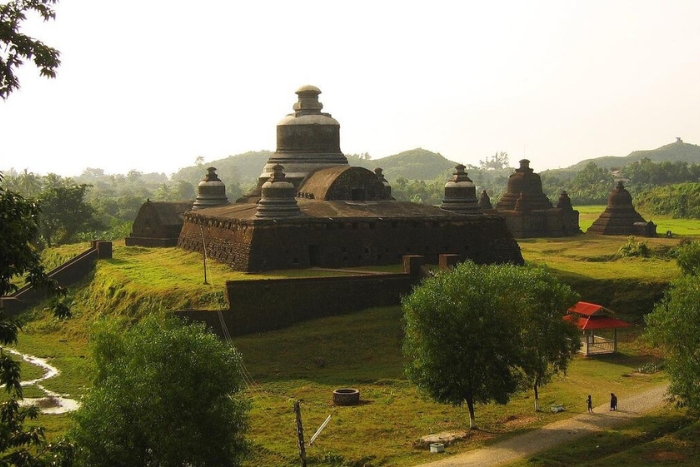
In Mrauk U, everything seems old and ancient, especially since the city was forgotten for quite a long time. This gives the place a sense of desolation and mystery, but don't worry—there are hidden treasures waiting for you to discover!
2. Visit Sittwe
Located in the western part of Myanmar in Rakhine State, Sittwe is a common stopping point for people en route to the stunning Mrauk U. If you have time, however, spending a few days in Sittwe itself is recommended. There are some interesting things to see and do in Sittwe, and it is well worth a few days’ stay.
Explore Sittwe Market: Visit the lively Sittwe Market, known locally as 'Thiri Mingalar Zay,' and experience the local culture. As you walk through the stalls, you'll see a variety of fresh vegetables, seafood, fabrics, and tasty snacks. It's also a great place to find Rakhine traditional crafts like handwoven longyis. Don't miss the chance to try local dishes at the food stalls, such as Mont Ti, a delicious noodle soup. Chat with the friendly locals and get a real feel for Sittwe's culture.
Visit the Rakhine State Cultural Museum: The Rakhine State Cultural Museum is a must-see in Sittwe. It offers a glimpse into the history and culture of the Rakhine people of Myanmar. You'll find interesting items like ancient Buddha statues, traditional clothes, musical instruments, and carvings that tell stories of local legends and daily life. The museum also has old manuscripts and photos of historic sites, giving you a deeper understanding of the Rakhine way of life.
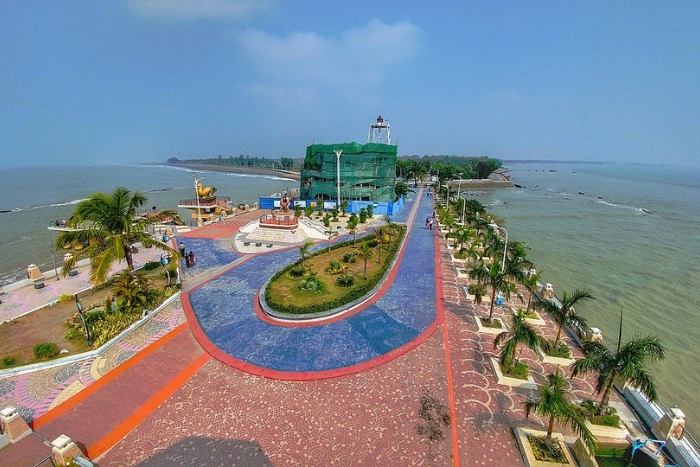
Watch the Sunset at View Point Beach: Take a walk along View Point Beach, where the Kaladan River meets the Bay of Bengal. It's the perfect spot to watch the sunset and meet locals who gather here to end their day. The soft sand, gentle waves, and peaceful atmosphere make it a relaxing place to visit.
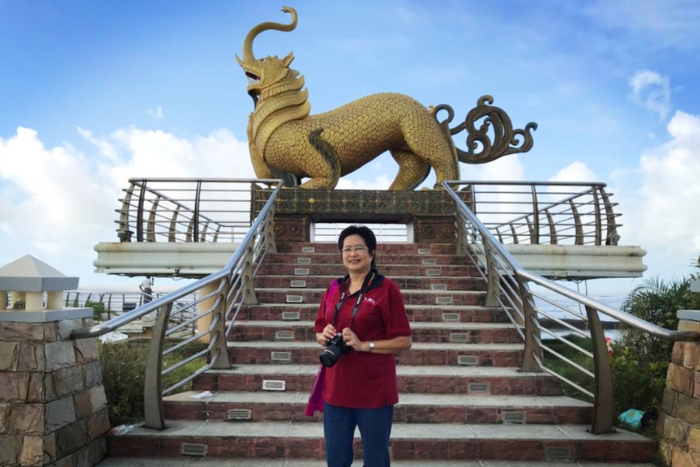
Kayaking in the Bay of Bengal : If you’re looking for adventure, try kayaking in the Bay of Bengal. It’s a fun way to explore Sittwe’s waters and see local marine life. You can rent a kayak along the coast, and even beginners will find the calm waters easy to paddle. As you glide along, you might pass fishing boats, giving you a unique view of life in the coastal communities.
And there are many other activities that you can explore in Sittwe, Myanmar in March, such as: Take a Boat Trip to the Mahamuni Buddha Temple, Attend the Rakhine Thresher Festival (during the season between January and February), Enjoy Traditional Rakhine Cuisine….
3. Explore Thandwe and Ngapali Beach
If you are wondering “What to do in Myanmar in March?”, the small weaving village of Thandwe is just 6 km from Ngapali Beach, one of Myanmar’s most famous beach spots. If you're traveling on a budget, staying in Thandwe and taking a bus to the beach is a great way to save money. The town has a colorful market where you can find tasty food and supplies. Renting a bike is a fun way to explore the area, letting you ride along sandy paths to discover nearby villages like Kinmaw, known for its clay pottery. There’s also a peaceful lake nearby, perfect for fishing or bird-watching.
Ngapali Beach, Myanmar’s top beach destination, offers a true paradise with its white sandy shores and clear blue waters. Interestingly, its name comes from the Italian “Napoli,” meaning the city of Naples. It’s ideal for those who want a relaxing time surrounded by nature, with a calm atmosphere, local fishing life, and Rakhine culture.
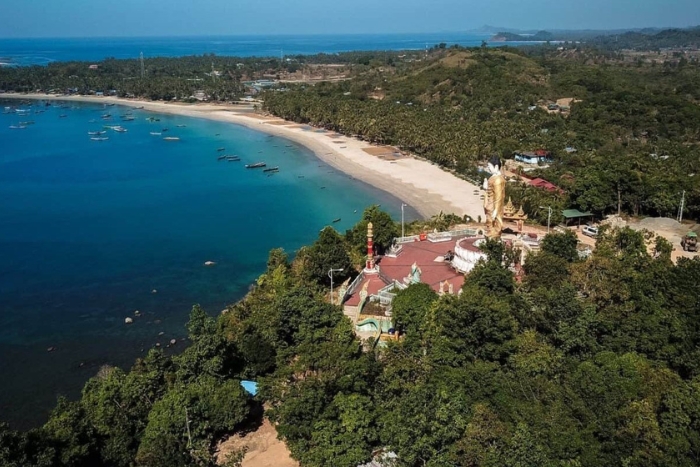
At Ngapali, you can enjoy stunning sunsets, take boat trips to Pearl Islands, and visit the black sand Zalat Htone Island. You can also relax under the palm trees and explore the clean white beaches. Renting a bicycle lets you visit fishing villages and Kinmaw to see traditional pottery making.
For dining, check out local restaurants like View Islet BBQ, located on a small island. There are many resorts available, making your stay comfortable. Besides beach fun, you can visit fishing villages, explore local markets, or take boat trips to nearby islands.
What to do in Myanmar in March? Discover the local market at Ngapali, where you can find unique souvenirs to remember your trip. The market is full of colors, with locals selling everything from vegetables and fish to handmade crafts – perfect for a memorable keepsake!
4. Discover Putao
What to do in Myanmar in March? Putao, located in Kachin State in northern Myanmar, is famous for its stunning natural beauty, diverse wildlife, and rich culture. Spring (March to May) is a great time to visit, with temperatures ranging from 15°C to 25°C and blooming flowers.
Surrounded by mountains, including some snow-capped peaks, Putao is a peaceful escape for adventurers and nature lovers. You can enjoy trekking through pristine forests and visiting traditional villages.
Trekking to Mount Hkakabo Razi: This trek to Mount Hkakabo Razi is challenging but rewarding, offering breathtaking views and unique flora and fauna. Be sure to hire a local guide and secure the necessary permits and equipment for this adventure.
Visiting Mulashidi Village: Experience the Lisu people's culture in Mulashidi Village is another essential stop when listing things to do in Putao. You can immerse themselves in the lifestyle of the Lisu people, an ethnic group following age-old traditions and practices in Putao. Walk through their traditional homes, learn about their heritage from Myanmar, China, India, and Thailand. Or you can buy local crafts, and enjoy cultural performances. Don’t miss trying traditional Lisu dishes for an authentic experience.
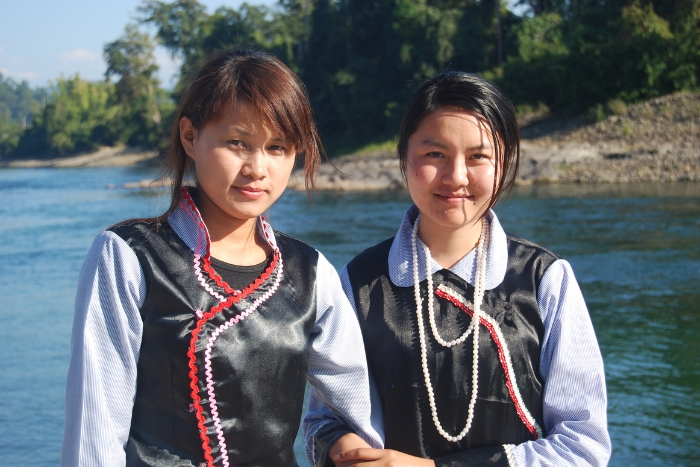
Rafting on the Nam Lang River: For thrill-seekers, rafting on the Nam Lang River is a must. Navigate thrilling rapids while enjoying stunning views—perfect for adventure lovers, especially with weather in Myanmar in March.

Bird Watching: Putao is a birdwatcher’s paradise, home to many endemic and migratory species. Early mornings are ideal for spotting rare birds like the black-breasted thrush and Blyth’s kingfisher.
Visiting Hot Springs: End your day with a visit to Putao’s natural hot springs. The mineral-rich waters provide a soothing experience amid beautiful surroundings, perfect for relaxation after a day of adventure.
III. Special Events in Myanmar in March
1. Kakku Pagoda Festival in Taunggyi
What to do in Myanmar in March? Exploring the Kakku Pagoda Festival, celebrated for three days, beginning on the 14th waxing of Tabaung in March. This vibrant festival takes place at the Kekku Ancient Pagoda Complex, near Taunggyi in Southern Shan State.
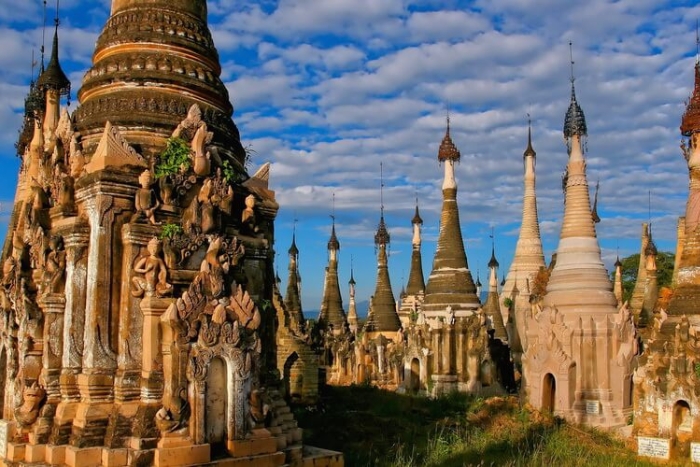
The Kakku Pagoda Festival, celebrated by the Pa-O tribe, marks a joyous harvest celebration. During this time, vendors arrive with ox-carts filled with their harvest to sell. The earnings from these sales are generously donated to the pagoda, allowing the vendors to gain merit in the process.
As people gather at the pagoda, the atmosphere is filled with traditional costumes and activities honoring the Buddha image. This festival is open to tourists from around the world, creating a unique blend of cultural exchange. The vibrant market scene showcases a variety of goods, and visitors can enjoy strolling through the area, observing the lively interactions between locals and tourists alike.

The festival also features performances by roaming artists and offers a glimpse into the religious sentiments of the Myanmar people. It serves as an important religious occasion for locals while contributing significantly to the country’s economy.
Overall, the Kakku Pagoda Festival is a remarkable event that highlights the rich cultural heritage of Myanmar in March and provides an unforgettable experience for all who attend.
2. Shwedagon Pagoda Festival in Yangon
The Shwedagon Pagoda Festival is celebrated for approximately one week leading up to the full moon day of Tabaung, which falls in March. This significant festival takes place at the iconic Shwedagon Pagoda in Yangon.
The Shwedagon Pagoda Festival is one of the biggest events in Myanmar in March, offering visitors a deep sense of the country's spirituality. During the festival, thousands gather to participate in temple fairs and observe various rituals, immersing themselves in the local culture.
The festivities typically last for about half a month, filled with activities and traditional Buddhist rituals. Each morning, participants dressed in traditional attire walk barefoot around the stupas in the temple complex. The atmosphere becomes deeply spiritual as monks ring the gong and begin chanting, creating a sense of devotion and peace.
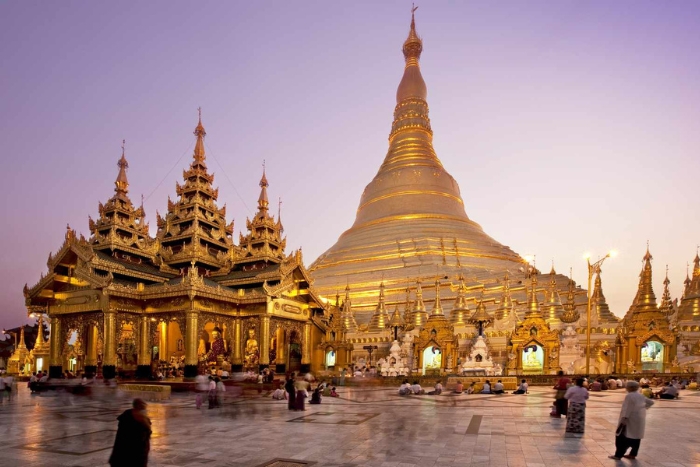
Throughout the 15 days of the festival, a group of 12 monks takes turns chanting until March 7, marking the end of the celebration. Locals recite prayers alongside the monks, surrounded by the golden stupa, illuminated by flames, candles, and incense sticks.
One notable tradition involves pilgrims moving clockwise around the stupa, which is believed to bring great merit. Visitors also weave holy robes for Buddha images using traditional looms. Monks lead prayers to honor the festival, while locals generously donate necessities to support the monks and the temple.
Overall, the Shwedagon Pagoda Festival is a vibrant display of faith, culture, and community, attracting both locals and tourists to celebrate together.
3. Shwenattaung Pagoda Festival
What to do in Myanmar in March? Discover the Shwenattaung Pagoda Festival, celebrated for eight days, from the 8th Waxing to the Full Moon Day of Tabaung, typically in March. This vibrant festival takes place in ShweTaung, located in the Bago Region of Myanmar.
The Shwenattaung Pagoda Festival is one of largest and most anticipated celebrations in Myanmar in March, drawing thousands of visitors each year. During the festival, locals participate by donating food and essential items to monks, creating a sense of community and gratitude.
Pilgrims arrive with bullock carts to pay their respects to the pagoda, adding to the festive atmosphere. The festival serves as both a harvest celebration and a time for almsgiving. Monks nearby attend the ceremonies to receive donations of food, daily necessities, small gifts, and uncooked rice.
The surroundings are filled with a carnival-like energy, as people bustle in and out of the fair. Both tourists and locals enjoy browsing a variety of goods sold by merchants, including handicrafts, food, toys, and souvenirs. This lively festival offers a unique experience, blending spirituality with a joyful celebration of community and culture.
4. Novitiation Ceremony (Shinbyu)
The Novitiation Ceremony, known as Shinbyu, is celebrated for two days during the months of Tabaung and Tabodwe, typically in March and April, coinciding with school holidays and preceding the Water Festival. This important ritual takes place throughout Myanmar.
What to do in Myanmar in March? Explore the Novitiation Ceremony, a significant coming-of-age event for boys under 20 years old. During this time, boys embark on a journey to learn the ways of Buddhism, guided by monks. Families take immense pride in their sons' participation in this esteemed merit-making ritual.
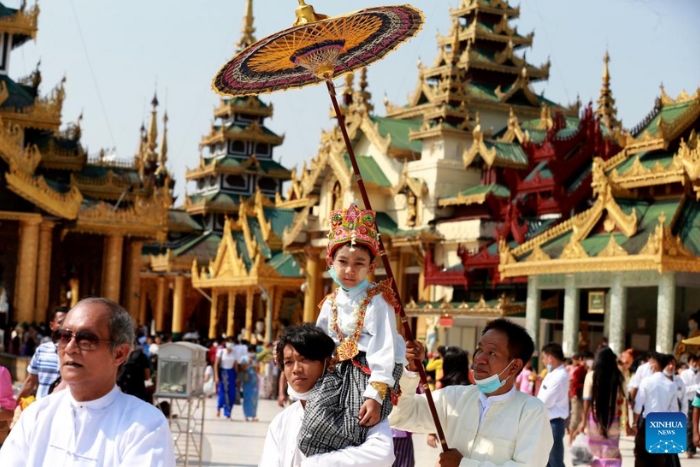
Dressed in silk robes resembling those of the monks, the boys walk through their towns, proudly announcing their intent to join the monasteries for religious training. Upon arrival, they seek acceptance and have their heads shaved as part of the ceremony.
This deeply rooted tradition not only instills spiritual values in the boys but also strengthens family bonds and community pride, making it one of most cherished cultural events in Myanmar in March.
IV. Myanmar in March Travel Tip
Due to ongoing internal conflicts in Myanmar, many areas require permits for tourist access. Therefore, it's essential to know where you shouldn't go.
The majority of the population (80%) practices Theravada Buddhism, so dress conservatively and be mindful of your behavior in religious places and when interacting with monks. While some locals may wear shorts in cities, it’s generally considered disrespectful; shorts and T-shirts are often seen as undergarments.
When visiting temples or homes, you must remove your shoes and socks. Bare shoulders and knees are not allowed inside temples, and women may be restricted from entering some temples.
Avoid touching monks and nuns or shaking their hands; a slight bow is the appropriate greeting.
Note that tap water is unsafe to drink.
You can purchase a Myanmar SIM card upon arrival at the airport, and Wi-Fi is typically available in hotels, restaurants, and cafes.
Cash transactions are common, and US dollars (USD) are often accepted. While you can exchange USD for Kyats, it’s best to carry plenty of cash, as credit card payments may incur extra fees.
Although tipping isn’t customary, small denominations (K200, K100, or K50) are appreciated for donations at larger temples.
March is one of the best times to visit Myanmar, offering perfect weather and vibrant cultural experiences. From the ancient temples of Mrauk U and bustling Sittwe markets to the stunning Ngapali Beach and the natural beauty of Putao, there's something for everyone. Don’t miss the lively Kakku and Shwedagon Pagoda Festivals, which showcase the country’s rich traditions. With practical tips for respectful travel, AUTOUR ASIA, Travel and Tour in Myanmar is here to help you create unforgettable memories. Embrace the magic of Myanmar in March and discover why this is the ideal time to explore this captivating destination!
>> Myanmar Day Trips
>> Hot air balloon ride in Bagan, Myanmar
>> Tour package in Myanmar
>> Myanmar 9 days
Related travel guide
Other similar articles
CUSTOMIZABLE BY LOCAL EXPERTS
Personalized trip at the original price!
REFUND GUARANTEE
We believe in our work and promise to give you money back.
GOOD PRICE / QUALITY
95% satisfied more than expected!
24/7 LOCAL SUPPORT
We are always available online to provide assistance at any time.
Most read articles
Autour Asia is highly recommended on
Embracing the mission of "Satisfied more than expected" and providing authentic experiences, we have received numerous recommendations on reputable travel forums:












